Hello Avid Readers! This week you’ll be hearing from Olivia Maule. She has spent (or suffered 😆) a semester with us and would like to share her experience involving science communication with the PIO. I will miss Olivia because she made valuable contributions to our office!
Getting Started
My name is Olivia, and if you are a devoted blog reader, you may recall that I joined the PIO (Pesticide Information Office) this past September. My role was to assist Dr. Emily Kraus in content creation. You may have also noticed that while the PIO website contained useful information, it was scattered across different website sections that were often difficult to find. My job as an intern was to not only fix these problems, but to also ensure that the content was aesthetic, engaging and cohesive. However, I felt apprehensive due to my limited background in content creation, especially knowledge of the pesticide world. Keep reading to find out what changes were made in your UF pesticide community!
Working on Webs: The Internet Kind
FAQ Pages
If I were to characterize myself as any person in the pest world it would be as a member of the ‘General Public’. This essentially refers to anyone who is not a professional involved with pesticide application. My attention naturally gravitated towards this page on the website. On this page, I noticed that there was not a designated space for questions to be asked or acknowledged. I wanted to create the opportunity for people to access a quick answer to what could potentially be a common question that the PIO often receives. The ability to create this information hotspot for general audiences was one of the more fulfilling aspects of my work, specifically because I identified with this community. Finally, I felt like a true advocate for homeowners and those interested in using pesticides in their own backyard.

The Aesthetic Archives: Adding Photos
Being a young adult, I look at life through rose-colored lenses. That included looking through the PIO website. My next challenge was enhancing the aesthetic of the information being presented. The rich content of photographic archives belonging to IFAS was a process that unveiled my search for perfection. I prioritized attaining access to photos within the database that would relate to the audience and allow them to identify written information more clearly. I found myself yearning for colors outside of the classic blue and orange. There are archives of decade-old photographs which I scoured through until I found the picture-perfect images (literally) to correlate with the information presented. The ‘Applicators’ and ‘Agents’ pages were finally popping out from an otherwise crowded page with several dropdown menus.
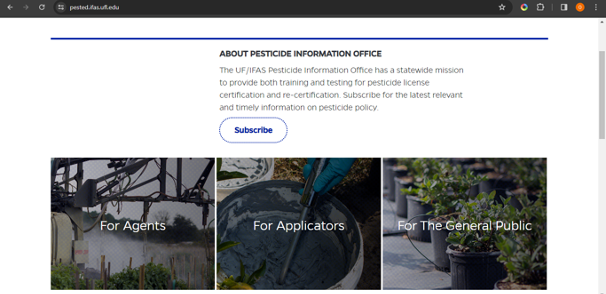
Streamlining: A Step-By-Step Approach
A notable issue when reorganizing the website was the breadth of information regarding license exams and requirements. I had to shift my mindset from PIO intern to a pesticide applicator looking to renew or attain their license. Without clear information on how to acquire pesticide licenses, this page needed some work. Because these regulatory processes can be difficult to follow and understand, I wanted to streamline this process with an efficient, numbered system. The ability to think like a pesticide applicator and a website builder simultaneously was a task that enhanced my ability to empathize with niche audiences and create solutions to perceived problems. With the help of my mentor, Dr. Emily Kraus, we were able to create a cohesive step-by-step process for pesticide applicators to test for new licenses, renew licenses, and study for their respective exams.
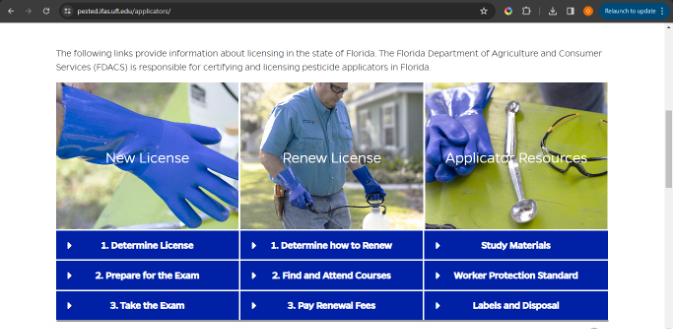
The Beetles: Don’t Always ‘Let it Be’
Biological Control Video

My second task as an intern was to create a video about pesticide knowledge and/or management. I was given a seventy-one-page PDF, access to Camtasia (a video editing platform) and infinite freedom in choosing how to direct and create the video. Being a biologist- I had never been given this much flexibility in science. This daunting task was nevertheless a rewarding experience. After choosing ‘Natural Area Management’ as my topic, I chose to delve further into using insects as a method of biological control.
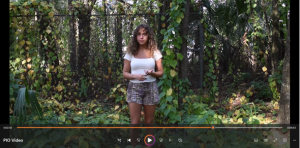
I focused on the invasive air potato plant (Dioscorea bulbifera) and the air potato beetle (Lilioceris cheni). Air potato plants are one of the biggest threats to vegetative diversity across Florida. Introducing air potato beetles (their natural enemies) to their habitats can mitigate their spread. The beetles will control their population by feeding on leaves and inhibiting the production of bulbils that generate new plants plant. Being a biologist, there was no doubt in my mind I would make this my topic. Check out my video here!
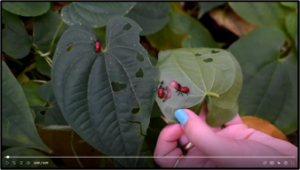
¡Y en Español!
To be completely honest, my presentation of biological alternatives to chemical pesticide application was completely a projection of my passion for both biology and entomology. I made this video even more my own by creating a Spanish version of the content. Besides being a member of the ‘General Public’ in the pesticide community, I am also part of the community that loathes when mouth movements do not align with the sounds heard on media. So yes- I recorded the Spanish videos separately from the English ones! Feel free to check it out here!
Some Takeaways
Overall, these past four months have been integral to catalyzing my growing interest in science communication. My research background has taken me from Gainesville to the Amazon. I have found that communicating science can be a larger barrier than trekking alone in the rainforest. Being able to tinker with websites and create original contributions to the pesticide world has been a valuable experience. I hope to replicate these new skills in distinct capacities. A very special thank you to my amazing and supportive mentor Emily!
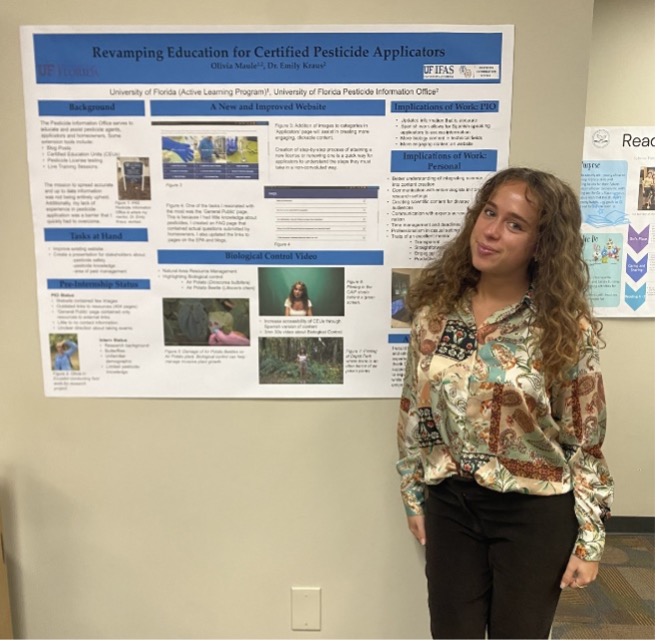
 7
7
